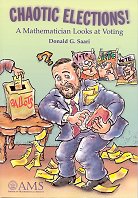Arrow's famous theorem states that, given some axioms desirable in
any voting system, the only voting system that obeys those axioms is a
dictatorship. This is a problem: if all the axioms are desirable, how
can we resolve the conflict?
p13.
the winner of an election may more
accurately reflect the choice of a decision procedure rather than the
views and preferences of the voters.
The problem is not restricted to elections. Any time we use a
decision process to chose an alternative -- say, the most efficient
manufacturing process, or the "best" choice of product -- we
run into the same problems.
Saari analyses the problem in detail, and makes it clear that one of
the axioms (binary independence: that the relative ranking of A and B
should be independent of the ranking of C), although apparently
reasonable, is the cause of all the problems, and is in fact not at
all reasonable in a "sophisticated society". This is because
the binary independence requirement loses information about how
voters rank candidates in a dangerous way: it allows the possibility
of "irrational voters" (those that prefer A to B, B to C,
and C to A). Because this loss of information allows silly cases, it
cannot enforce sensible cases.
More generally, reducing a problem to parts can lose essential
information needed to put those parts back together in the correct
way:
pp104-5.
Expect paradoxical phenomena whenever
there is a potential discrepancy between the actual unified whole and
the various ways to interpret the totality of disconnected parts.
Whenever this is true, whenever the "instruction sheet"
describing how to connect the parts is dismissed, lost, or ignored,
expect the unexpected; anticipate bothersome and unexpected outcomes
to arise in a subtle, unexpected manner.
… the natural tactic of
solving a complicated problem by dividing it into "parts."
This separation may be promoted in the name of "efficiency;"
it may be rationalized as a means to simplify the analysis. But, this
division, this decentralization, this approach we have been taught to
embrace, can be a hidden, pernicious "killer assumption" ...
… this "assassin
assumption" of emphasizing the parts forms a natural explanation
for differences found so often between the micro and macro
examinations of so many disciplines. After all, the explicit purpose
of the micro study is to understand the structure of a specified "part"
of the field as disconnected from the other structures. The micro
approach is a valued, necessary strategy. But, when attempting to
understand a macro concern by using information from micro studies,
the importance of using "connecting information" among the
micro parts must be acknowledged.
...
This loss of connecting information most definitely occurs in
general decision making whenever the societal outcomes of "parts"
has a de facto precedence over the whole. This includes those commonly
used procedures, such as agendas and tournaments, which reach a final
conclusion in terms of disjoint decisions about "pairs." ...
Saari also covers other related cases, including Sen's theorem and
Simpson's paradox
(where aggregating data can reverse the conclusion of the individual
parts). It's all about problems arising from losing information. This
leads Saari to wonder:
p108.
Could there be settings where the global
"optimal" outcome requires putting together "suboptimal"
parts?
More to the point, this illustrates that the "optimality"
of parts cannot be decided in reductionist isolation. Their fitness
depends on the context, on which "whole" they form a part.
Another case Saari touches on, where lost information can result in
unhappy results, is striving for fairness:
p129.
Insisting on fairness by worrying about
pairwise comparisons, or comparisons of this group versus that one,
emphasizes the "parts."
The solution Saari recommends is to use the "Borda count":
for n choices, each voter gives them a ranked value from 0 to
n-1. The sum of all voters' rankings gives the final ranking.
This reintroduces the lost information and ensures voters are "rational"
(there is no way to state a cyclic preference in this approach). But
it loses binary independence: C's ranking can affect (reverse!) the
relative ranking of A and B. However, we have to be educated to
realise that this is a necessary consequence of being a "sophisticated"
voting society.
p166.
the political correctness of pairwise
comparisons has blinded our thinking about the fundamental traits of
choice procedures. Even today procedures are criticized if they fail
the binary independence test. This condition has so colored our
thinking that, rather than questioning and modifying "binary
independence." it is more popular to explore what happens by
tinkering with Arrow's other assumptions. This approach resembles the
old story of the drunk losing his car keys in the bushes but searching
for them under a street light where it is easier to see.
Recommended reading for anyone thinking of using or inventing a
voting system or decision-making procedure.
